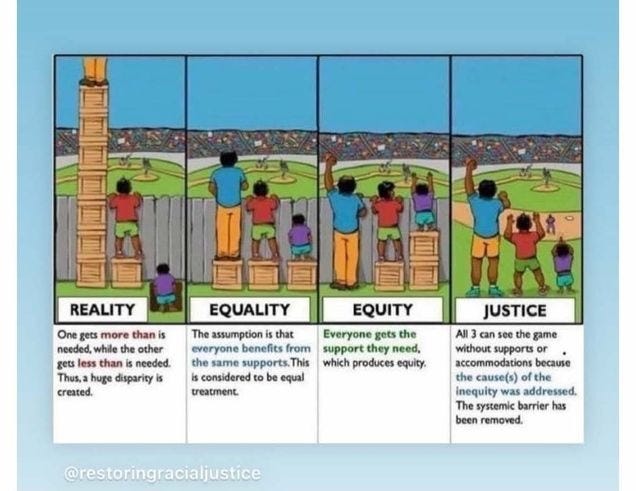Inclusion-washing
What happens to inclusion—and purpose and values—when the motive is profit
Hi there! You’re reading the Bonfire newsletter from Kevan Lee & Shannon Deep. Each week, we highlight brand, marketing, and creative learnings from our experience as in-house marketers turned agency owners who think a lot about creativity, our relationship to work, and how all of that impacts our identities. We’ll also feature insights from our digital community of super smart folks (which you’re welcome to join).
Wishing you a great week!
“If you stand for everything, you stand for nothing.”
This quote has been rattling around in my head recently, as we’ve been working through various client engagements at our Bonfire branding agency and reliving all the values explorations from our recent Bonfire retreat. I’ve got purpose on the brain.
The saying might sound familiar because it is a riff off the famous quote from either Alexander Hamilton or Malcolm X (the Google Gemini attribution is spotty): “If you stand for nothing, you’ll fall for everything.” I’ve been misremembering the quote for years apparently. Although I quite like my version; thank you, Mandela Effect!
In addition to this quote, I’ve also been thinking a lot about inclusion.
And here’s where Pandora’s box cracks open a little.
Is it possible to both be principled about your values and be inclusive?
When does standing for something prevent you from welcoming someone?
This has been relevant for me in past in-house roles as a marketing leader and in our current agency engagements with startup brands because companies love putting inclusion into their values. We love it, too! But we especially want to make sure that we’re all on the same page about what inclusion means, how inclusion works, and what happens when you build a purposeful brand that aspires to be inclusive.
Let’s unpack it further.
Defining inclusion
We’ve found that a lot of times inclusion gets used as a blanket brand value that gives companies an excuse to welcome everyone—all customers, all revenue, all opportunities—without having to be discerning about values alignment.
It’s inclusion-washing, of a sort.
Inclusion wasn’t meant to be a way to avoid hard conversations. Quite the opposite in fact! Here’s a definition of inclusion:
Inclusivity means making sure everyone feels welcome, valued, and respected, no matter who they are or where they come from
Sounds pretty great, tbh. And it sounds like a value that would spark real conversations about who currently doesn’t feel welcome, and why, and what to do about it. This is especially true when we look at inclusion alongside the other elements of DEIB: Diversity, Equity, Inclusion, and Belonging. It paints a complete picture:
We are a community of different people (diversity)
Who benefit from the same resources and opportunities (equity)
And all feel welcomed into the space (inclusion)
And are treated as if we belong here (belonging)
Across DEIB initiatives and within a personal set of values, inclusion feels incredibly proactive. You can actively welcome people into a space—a safe space—where you can shower community love on them.
In the corporate world? Inclusion tends to take on a “we’re for everyone” tint. The definition gets tweaked and expanded, often to include things that inclusion is NOT.
Inclusion is not tolerance.
Tolerance is passive acceptance, like enduring differences, while inclusivity is active and proactive, creating environments where everyone feels welcomed, valued, and has an equal opportunity to participate.
Inclusion is not equality.
Equality provides everyone with the same resources and opportunities, while inclusion is the practice of ensuring that diverse individuals feel welcomed, valued, and supported, and have a sense of belonging. (And equality is not equity, which provides resources according to need.)
A favorite explanation is this graphic that shows that equality is also NOT fairness—nor is it reality or liberation.
Inclusion is not permissiveness.
Inclusivity is the intentional effort to ensure everyone feels welcomed, valued, and has equal opportunity, while permissiveness is the act of being lenient and allowing people a lot of freedom, often with few rules or boundaries.
The muddle with inclusion as a brand value
Inclusion is stickier than it seems, especially as a brand value for a startup business.
Let’s pretend that your startup chooses inclusion as a value. Congrats! Great choice. Now comes the hard part of actually putting this value into practice and having real conversations about its implication.
Going back to the definition, inclusion means creating a welcoming space for people. Well, what would you do in the following scenarios:
What if the people you’re welcoming are staunchly against your other values?
What if two of the people you welcome are so at odds with one another that they make the space unsafe for each other?
What if you welcome an oppressed group and its oppressors?
Should neo-Nazis feel welcome? (A literal problem that Substack is facing)
And then there’s the (potentially literal) million-dollar question for businesses:
Would you be comfortable saying no to someone who doesn’t adhere to your values?
Inclusive because money ≄ inclusive
The complicating factor in all this is, unsurprisingly, money.
Can a company motivated by profit really truly be authentically inclusive?
The “all are welcome here” version of inclusion is good for business because it maximizes your Total Addressable Market (TAM), which maximizes your revenue, which maximizes your shareholder value, etc. Inclusion is strategic, whether explicitly or implicitly, so it is therefore championed. Not to be too cynical about it, but inclusion can be a convenient excuse for companies to abandon critical thinking when it comes to who they allow as customers, no matter the problem.
Inclusion has attained great reverence in the business world, reverence earned deservedly from all the good that it has done to combat discrimination and inequality but also, problematically, because of the excuse it provides for profit maximization. Inclusion is on a pedestal, head and shoulders above all the other brand values. (Except maybe trust; CEOs love trust.)
If inclusion is untouchable, then how can you ask the hard questions?
If you can’t ask the hard questions—see the list above—then how can you ensure that you’re creating a safe space?
Profit-motivated inclusion puts welcoming ahead of safety. People won’t be excluded, but might they be harmed?
And if people are being harmed, are you actually living your other values?
What we do instead
For us, we’re not opposed to working with clients who want to lean into inclusion as a brand value. We clearly have lots of love for it and lots to say on the topic! Instead of shying away, we instead try to bring a balanced approach to the conversation and get people thinking through the following aspects.
What is it about inclusion that appeals to you?
Often, this might reveal other value attributes that we can use instead of inclusion, values that are more specific or more actionable for the client.
For instance, at Bonfire one of our brand values is connection, which is very much in the same universe as inclusion but has a clearer sense of purpose and action for how we live out our work day-to-day.
What other values does inclusion live alongside?
We advise most brands to have 3 to 5 brand values, which helps create a more robust, unique, and personal brand universe. It also creates some checks and balances across all the values. So if inclusion is a value that a company holds, we can put this value to the test by seeing how it relates to the other values in the stack.
How might a company act if it values inclusion and innovation?
What might a company choose to do if it’s living up to values of inclusion and justice?
What do you stand for?
This is the scariest one! And in a lot of ways it can feel like a contradiction to a value of inclusion. When you stand for something, you run the risk that not everyone will choose to stand with you. You could lose customers. You could lose revenue. You could lose friends. .
Stating your beliefs is not a neutral exercise.
These risks prevent a lot of people and brands from ever rocking the boat. Nevertheless, we encourage people to do some rocking. Boats were built to endure it!
And ultimately we believe every business SHOULD stand for something. The world is full of commoditized categories of goods and services, so why does any new business need to exist? The answer to the “why” question is the answer of purpose. And brands with a purpose exist to solve real needs, to show up in original ways, to start conversations that may not happen otherwise, and to build community around a shared worldview and values. Which is a form of inclusion!
Over to you
How have you seen inclusion show up as a value for you personally? How does it show up differently as a value at work? We’d love to hear from you!
Upcoming Campout events
This month, join us for:
Workshop & Chill: Studio Session. We’re hanging out with Campout community member Jennifer Betz in an interactive meetup where we’ll be working through real-life creative challenges together. Jennifer has offered to share her work as a jumping off point for a tactical and practical community brainstorm. Join us Wednesday, November 19, for this awesome event!
In Campout, our digital community, we talk about stuff like this on the daily in our channels and a couple times a month in our live events. All supported by exercises and templates to help you craft a career with purpose and intention.
But wait! There’s more…
Wanna hang out in person?
We have an IRL retreat coming up next year: April 14-20, 2026 in Burgundy France. Registration is now open!
Wanna be friends?
If you love this newsletter and wish it were more interactive, you’re in luck! Join us over in Campout, our digital community for creative marketers and the creative curious.
Wanna work with us?
If you need help with brand strategy and storytelling, fractional brand and marketing leadership, and bringing your brand strategy to life in impactful ways, send us an email at hello@aroundthebonfire.com to get in touch.
As always, you can find us on LinkedIn, Instagram, and Threads.






